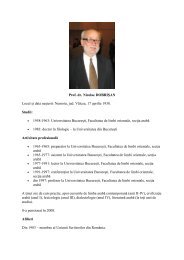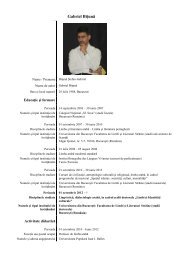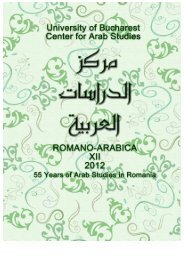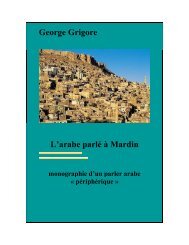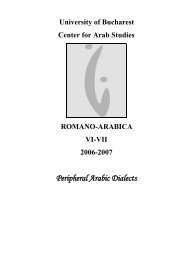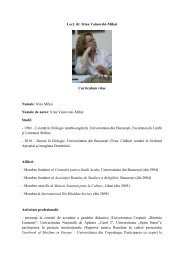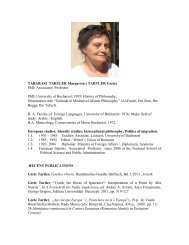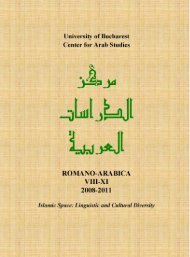Arabic Linguistics
Arabic Linguistics
Arabic Linguistics
You also want an ePaper? Increase the reach of your titles
YUMPU automatically turns print PDFs into web optimized ePapers that Google loves.
section on qiyās, 4 above) that the relationship between mā and the verbs it occurs<br />
with is equivalent to that between h}abba and dā in that they are inseparable and<br />
that they have together acquired the status (manzila) of one word. 47 Finally, the<br />
grammarians‘ discussion of sentences 23, qā‟iman kāna Zaydun abūhu, and 24,<br />
ākilan kāna Zaydun t}a„āmaka, reveals the close connection between regimen and<br />
coalescence as two basic analytical tools within one general system, and thus<br />
provides strong proof for the grammarians‘ ability to bring harmoniously together<br />
various elements of their repertoire in judging actual or proposed constructions. In<br />
this respect, they assert that the inacceptability of sentence 23 is due to the<br />
inadmissible separation between the operant qā‟iman and abūhu which, because it<br />
is the subject of the operant, is considered to be like one of its parts (li-mā fīhi min<br />
al-fas}l bayna l-„āmil wa-ma„mūlihi l-ladī huwa ka-ğuz‟ minhu 48 ). Conversely,<br />
t}a„āmaka, being an optional element (fad}la) – unlike abūhu which is an<br />
indispensable element („umda) – may be separated from its operant ākilan because<br />
it is not part of that operant (laysa ka-ğuz‟ min „āmilihi li-annahu fad}la 49 ).<br />
3. Hierarchy: Sībawayhi‘s Kitāb laid the foundations for a hierarchical<br />
system in which various linguistic elements can be arranged linearly. 50 Notions<br />
like ―hìffa‖ (lightness) and ―tiqal‖ (heaviness), tamakkun (declinability) and<br />
„adam tamakkun (indeclinability), being ―awwal‖ (first, e.g., masculine vs.<br />
feminine) or not, etc. were regarded as established facts which may be referred to<br />
not only for justifying usage, but also in deciding on its acceptability. The position<br />
of some grammarians vis-à-vis the separation between kāna or its sisters by a<br />
word which is governed by the predicate is of special interest here because it<br />
shows the link between hierarchy and regimen. The Basrans are reported here to<br />
have disapproved of such separation except when the intervening element is a<br />
preposition or an adverb, as in sentences 29, kāna „indaka Zaydun qā‟iman, and<br />
30, kāna fī l-masğidi Zaydun qā‟iman, because kāna is a weak operant („āmil<br />
d}a„īf). 51 This perceived ―weakness‖ is the result of the grammarians‘ belief that<br />
kāna and its sisters, as we have pointed out already, are incomplete verbs and are<br />
therefore analogous to ―real‖ or complete verbs. As such, they are seen to be a<br />
far‗ (branch) and not an as}l (origin, norm), and therefore hierarchically below<br />
―real‖ verbs which ―merit‖ larger syntactic flexibility. 52 As for the connection<br />
between hierarchy and syntactic position, it can be shown most clearly in the<br />
hierarchical position assigned to laysa by some grammarians. The most lucid<br />
explanation of this position is provided by Ğurğānī who establishes the<br />
relationship between laysa and two other operants, kāna and mā. He argues that<br />
laysa is weaker than kāna because the latter is fully declinable, but stronger than<br />
mā because laysa is a verb and can be followed by pronominal suffixes (e.g.,<br />
lastu, lastumā) whereas mā is a particle and cannot have suffixes attached to it. 53<br />
The conclusion he draws is that laysa has an intermediate position (manzila bayna<br />
51



